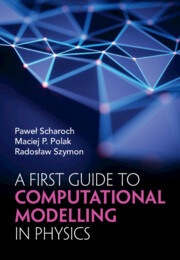Book contents
- Frontmatter
- Contents
- Preface
- How to Use the Book
- First Steps
- Project 1: Rectangular Finite Quantum Well – Stationary Schrödinger Equation in 1D
- Project 2: Diffraction of Light on a Slit
- Project 3: Pendulum as a Standard of the Unit of Time
- Project 4: Planetary System
- Project 5: Gravitation inside a Star
- Project 6: Normal Modes in a Cylindrical Waveguide
- Project 7: Thermal Insulation Properties of a Wall
- Project 8: Cylindrical Capacitor
- Advanced Projects
- Project 9: Coupled Harmonic Oscillators
- Project 10: The Fermi–Pasta–Ulam–Tsingou Problem
- Project 11: Hydrogen Star
- Project 12: Rectangular Quantum Well Filled with Electrons – The Idea of Self-Consistent Calculations
- Project 13: Time Dependent Schrödinger Equation
- Project 14: Poisson’s Equation in 2D
- Appendix A: Supplementary Materials
- Further Reading
- Index
Project 10: - The Fermi–Pasta–Ulam–Tsingou Problem
Published online by Cambridge University Press: 01 February 2024
- Frontmatter
- Contents
- Preface
- How to Use the Book
- First Steps
- Project 1: Rectangular Finite Quantum Well – Stationary Schrödinger Equation in 1D
- Project 2: Diffraction of Light on a Slit
- Project 3: Pendulum as a Standard of the Unit of Time
- Project 4: Planetary System
- Project 5: Gravitation inside a Star
- Project 6: Normal Modes in a Cylindrical Waveguide
- Project 7: Thermal Insulation Properties of a Wall
- Project 8: Cylindrical Capacitor
- Advanced Projects
- Project 9: Coupled Harmonic Oscillators
- Project 10: The Fermi–Pasta–Ulam–Tsingou Problem
- Project 11: Hydrogen Star
- Project 12: Rectangular Quantum Well Filled with Electrons – The Idea of Self-Consistent Calculations
- Project 13: Time Dependent Schrödinger Equation
- Project 14: Poisson’s Equation in 2D
- Appendix A: Supplementary Materials
- Further Reading
- Index
Summary
This chapter exploresthe Fermi–Pasta–Ulam–Tsingou (FPUT) problem in the context of a one-dimensional chain of interacting point masses. We start by modelling the system as a chain of masses interacting through a force dependent on their relative displacements. Next, we simplify this system to harmonic oscillators under a linear force dependency, further developing it to describe a wave-like behaviour. The chapter discusses dispersion relations and the impact of boundary conditions leading to discretisation of allowed wave modes. A non-linear, second-order interaction is then included, complicating the system’s dynamics and necessitating the use of numerical methods for its solution. We then track the system’s evolution in a multidimensional phase space, leading to observations of seemingly chaotic motion with emerging periodicity. Energy conservation and its flow through the system are crucial aspects of the analysis. A detailed numerical procedure is provided, involving solution of initial value problems, mode projections, and energy computations to explore the complex behaviour inherent in the FPUT problem.
Keywords
- Type
- Chapter
- Information
- A First Guide to Computational Modelling in Physics , pp. 64 - 71Publisher: Cambridge University PressPrint publication year: 2024



